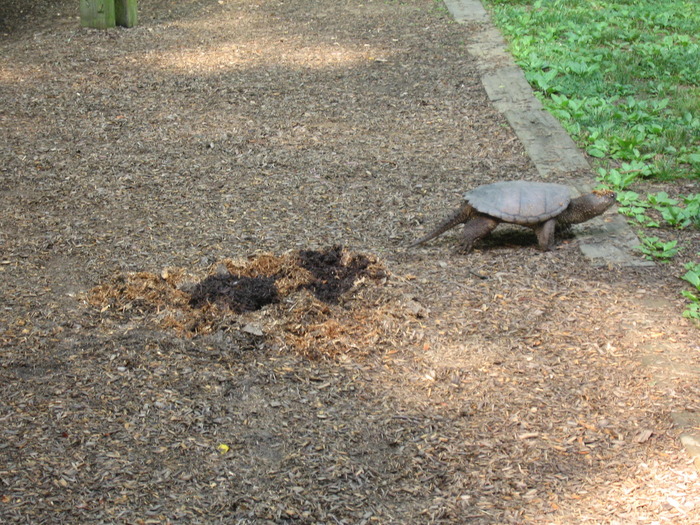Snapping Turtle Nest
Written by Beth Baker
Photos by Anne Williams
June 4, 2010
On June 4 at 8:30 in the morning, I was enjoying my usual walk in Sligo Creek, looking for birds. My neighbor, Ellen, jogged by and told me there was a large turtle in the playground up ahead.
Sure enough, as I approached I could see a very large turtle had dug a hole in the wood chips. Its neck was out and it was looking up intently – its dignity somewhat marred by a toupee of wood chips. The shell was perhaps 15 inches front to back.
I soon realized “it” was a “she” who was laying her eggs in the hole she had dug. I had once been near Amelia Island, Florida, when the sea turtles were expected to come ashore to deposit their eggs, but I never dreamed I’d see a large turtle laying eggs just a few feet from the path in Sligo Creek Park.

Every now and then, she would rise up a bit, a look of concentration on her face, and an egg would drop out.

I hurried home and called Clair Garman, a friend who is active in Friends of Sligo Creek. The two of us, and another neighbor, Anne Williams, returned to the maternity ward. Anne brought her camera to document our sighting.
By then other wildlife lovers had gathered. Together, we kept kids and pets away from the turtle – (as well as three workman who made us nervous when one said all we needed was a big pot and curry powder) — as she continued her labor. We received a number of opinions from passersby as to the turtle’s species. (“That’s not a turtle – it’s a terrapin.” “That’s a snapping turtle.” “That looks nothing like a snapping turtle.” And so on.)
Clair called wildlife experts at Montgomery County Maryland National Capital Parks and Planning Commission and one volunteered to come advise us on how best to protect the eggs. Our concern was that the eggs might easily be dug up by a dog or kicked up by an energetic child.
About 9:40 or so, her important mission complete, the turtle used her strong rear legs to cover the eggs. She then straightened up and slowly ambled back to the creek without a glance back. We could then fully see her impressively long saw-tooth tail. She stopped a few times, no doubt exhausted. When we last saw her, she was swimming underwater, quickly camouflaged in the brown water.



By then we had had plenty of time to study her, and indeed, she was a common snapping turtle (Chelydra serpentine), the only large species in Sligo Creek. When the park naturalist, Bill Hamilton, arrived, he felt that trying to move the eggs would do more harm than good, and so, they are where their mother meant for them to be.

I later read up on snapping turtles (Chelydra) and learned they lay from 25 to 80 eggs a year. (Who knew there was a website “dedicated to snapping turtles and the people who love them”?) Mother turtles will travel far from the water to find a good spot to deposit their eggs. Perhaps we were lucky the road construction was just completed, and it was quiet again in the park. The eggs hatch on average in 80 to 90 days – so at the end of summer, keep your eyes out for baby turtles!


